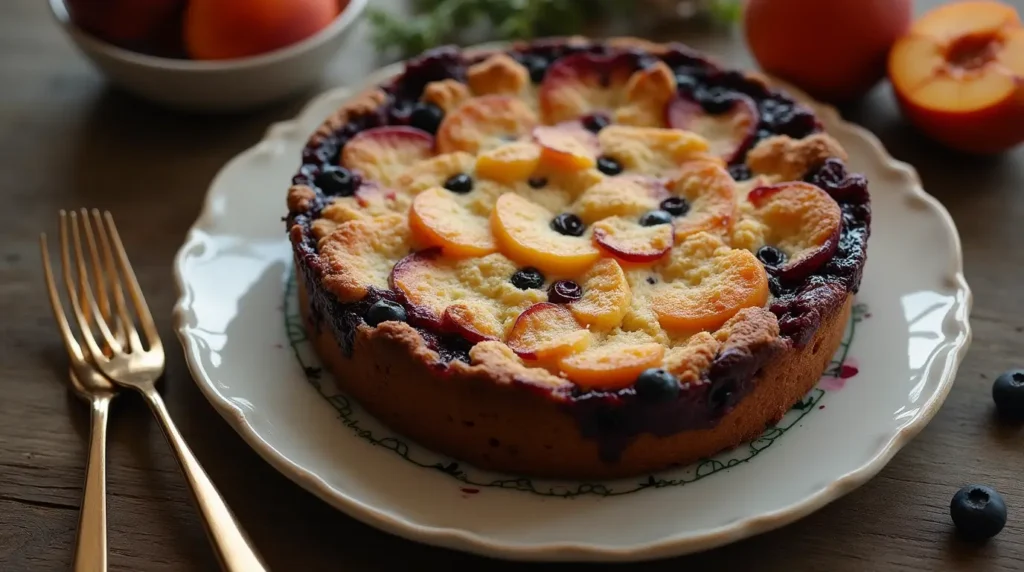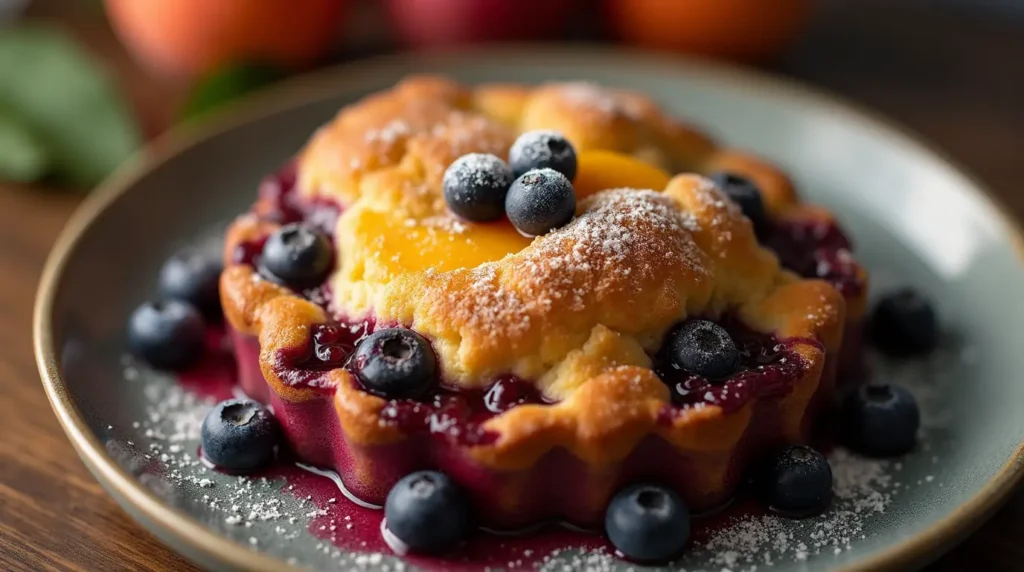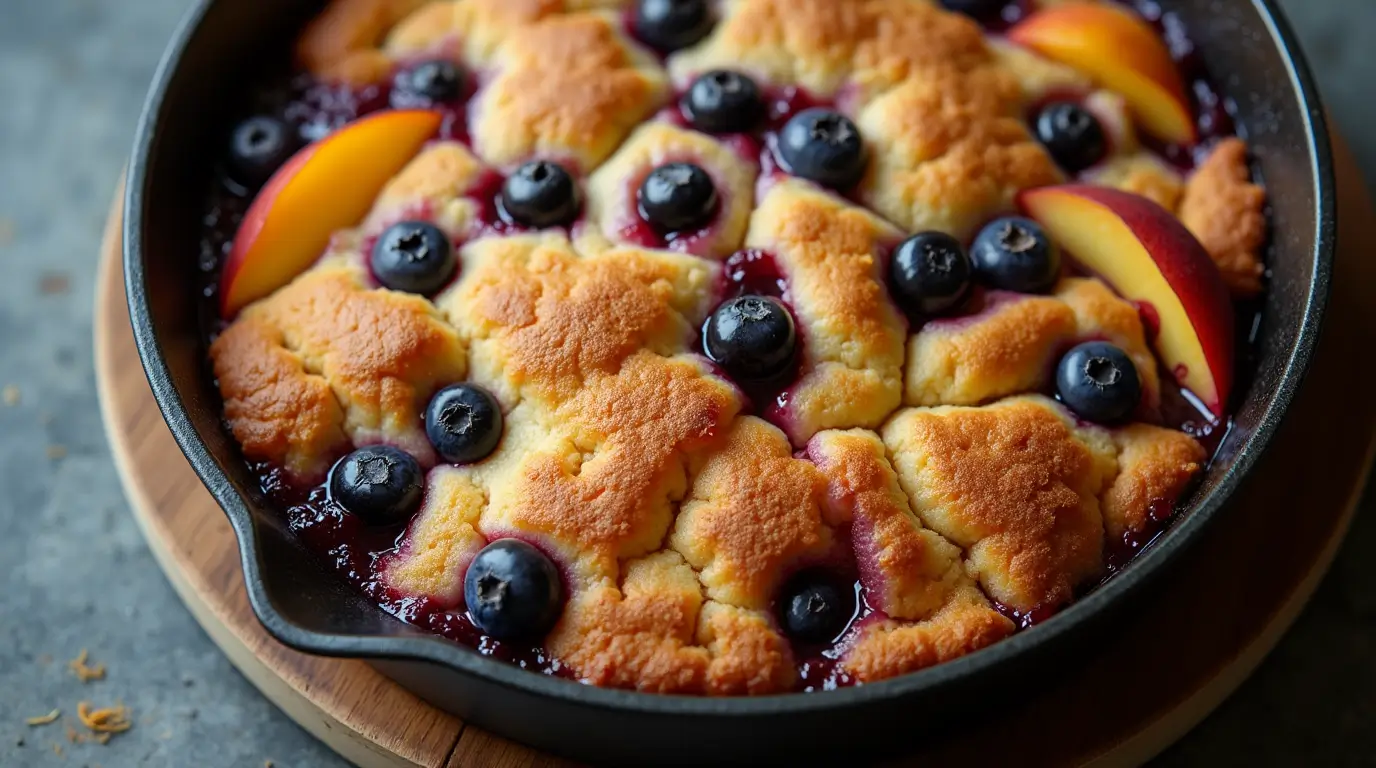Introduction
Peach and blueberry cobbler is a dessert that evokes memories of warm summer days and family gatherings. The pairing of juicy peaches with tangy blueberries creates a delightful symphony of flavors that’s hard to resist. This classic dessert, with its golden crust and fruit-filled base, is easy to make, endlessly customizable, and always a crowd-pleaser. In this article, you’ll learn everything from selecting the best ingredients to baking tips, variations, and nutritional insights. Let’s dive into this delicious world of cobblers!
Introduction to Peach and Blueberry Cobbler
What is a Cobbler?
Cobblers are a type of baked dessert that combines fruit fillings with a biscuit, batter, or crumb topping. Unlike pies, cobblers don’t have a bottom crust. Instead, the fruit is directly placed in the baking dish, topped with dough, and baked to golden perfection. The simplicity of this dessert is what makes it a favorite for many.
History of Cobbler Desserts
Cobblers originated in early American colonies, where settlers adapted traditional English pies to suit their limited ingredients. Instead of creating a pie crust, they used biscuit dough to cover their fruit fillings, creating the first cobblers. Over time, this rustic dessert evolved, and regional variations like peach cobbler and blueberry cobbler became beloved staples.
Why Combine Peaches and Blueberries?
Peaches and blueberries are a match made in heaven. The sweet, aromatic juiciness of ripe peaches perfectly complements the tart, vibrant flavor of blueberries. Together, they create a balanced dessert that highlights the best of both fruits. Not only do they taste incredible together, but they also bring a pop of color to your plate.
Ingredients for the Perfect Cobbler
Selecting Fresh Peaches
When it comes to peach cobbler, the type of peaches you use can make or break the dessert. Fresh peaches, especially those that are ripe and in season, bring a natural sweetness and juiciness that canned or frozen varieties often lack. Look for peaches that are slightly soft to the touch but still hold their shape when gently pressed. The skin should be free from major blemishes, and a sweet aroma indicates peak ripeness.
However, if fresh peaches aren’t available, canned or frozen options work too. Just be sure to drain the canned peaches or thaw frozen ones before use to prevent excess moisture from making the cobbler soggy.
Choosing the Best Blueberries
Blueberries are equally important in this dessert, adding a touch of tartness to balance the sweetness of the peaches. When shopping for blueberries, select berries that are firm, plump, and deep blue with a silvery frost. Avoid berries that are soft or have mold. If fresh blueberries aren’t an option, frozen ones are a fantastic substitute. Similar to frozen peaches, let them thaw and pat them dry to reduce excess water.
Other Essential Ingredients
In addition to peaches and blueberries, several other ingredients come together to create the perfect cobbler:
- Flour: A staple for creating a flaky and tender crust or biscuit topping.
- Sugar: Enhances the sweetness of the fruit and adds flavor to the topping.
- Butter: Provides richness and helps the topping achieve that golden-brown color.
- Lemon Juice: Adds a bright, tangy note that complements the sweetness of the fruit.
- Baking Powder: Helps the topping rise and stay light.
- Milk or Cream: Creates a soft, doughy texture for the topping.
- Spices: Cinnamon or nutmeg can add warmth and depth to the cobbler’s flavor profile.
Step-by-Step Preparation Guide
Preparing the Fruit Filling
Creating the perfect filling is the heart of a delicious peach and blueberry cobbler. Start by peeling and slicing your peaches. If you’re using fresh fruit, blanch the peaches in boiling water for about 30 seconds, then transfer them to an ice bath. This process makes the skin peel off easily. For the blueberries, simply rinse them and pat them dry.
In a large mixing bowl, combine the peaches and blueberries with sugar, lemon juice, and a sprinkle of flour or cornstarch to thicken the juices as the cobbler bakes. Add a dash of cinnamon or nutmeg for extra warmth. Stir gently to avoid bruising the fruit, ensuring everything is evenly coated.
Making the Cobbler Topping
For the topping, you’ll need a mixture of flour, sugar, baking powder, and a pinch of salt. Combine these dry ingredients in a bowl. Cut cold butter into small cubes, then use your fingers or a pastry cutter to work the butter into the flour mixture until it resembles coarse crumbs.
Next, add milk or cream gradually, stirring until the mixture forms a soft dough. Avoid overmixing; the dough should be slightly sticky but manageable. For a crispier topping, you can sprinkle coarse sugar over the dough before baking.
Assembling the Cobbler

Preheat your oven to 375°F (190°C) and grease a baking dish lightly with butter. Pour the fruit mixture into the dish, spreading it evenly. Drop spoonfuls of the prepared dough over the fruit, leaving small gaps to allow steam to escape during baking.
Bake the cobbler for 35–40 minutes, or until the topping is golden brown and the fruit mixture is bubbling. Let it cool for at least 15 minutes before serving. This rest time allows the filling to set and makes serving easier.
Nutritional Information (per 100g)
Here’s a breakdown of the approximate nutritional content:
| Nutrient | Amount |
|---|---|
| Calories | 120 kcal |
| Protein | 1.5 g |
| Fat | 4.5 g |
| Carbohydrates | 20 g |
| Fiber | 2 g |
| Sugar | 15 g |
Baking Techniques and Tips
Optimal Baking Temperatures
The success of a peach and blueberry cobbler often hinges on baking at the right temperature. Preheat your oven to 375°F (190°C) for the perfect balance of evenly cooked fruit and a golden topping. Baking at this temperature ensures the fruit filling thickens without overcooking, while the topping develops a crispy exterior with a tender center.
Achieving the Perfect Crust
A flawless crust makes all the difference. To achieve this, keep your butter cold while preparing the topping. Cold butter creates steam pockets during baking, resulting in a flaky, tender texture. Additionally, avoid spreading the dough entirely over the fruit. Leaving gaps allows steam to escape, preventing a soggy crust.
For an extra golden finish, brush the dough with a bit of milk or cream and sprinkle coarse sugar on top before baking. This step adds both color and a delightful crunch.
Avoiding Common Mistakes
Even experienced bakers can face pitfalls when making cobblers. Here’s how to sidestep the most common ones:
- Soggy Filling: Ensure you use thickening agents like flour or cornstarch in the fruit mixture. Too much liquid can make the cobbler watery.
- Overmixing the Topping: Overworking the dough can result in a dense, tough topping. Mix just until combined.
- Undercooked Fruit: Fresh fruit, especially firm peaches, needs sufficient baking time to soften. Cut fruit into uniform sizes for even cooking.
Serving Suggestions

Ideal Accompaniments
A warm peach and blueberry cobbler is delightful on its own, but pairing it with the right accompaniments takes it to another level. A scoop of creamy vanilla ice cream is a classic choice, as the cold, sweet cream contrasts beautifully with the warm, tangy cobbler. For a lighter option, try a dollop of whipped cream, which adds a touch of airy richness without overpowering the dessert.
If you’re looking for something unique, serve cobbler with a drizzle of honey or a spoonful of Greek yogurt. These additions balance the sweetness and enhance the dessert’s flavors.
Presentation Ideas
Presentation makes a lasting impression. Serve your cobbler in individual ramekins for a personal touch, or keep it rustic by presenting it straight from the baking dish. Garnish with fresh mint leaves or a sprinkle of powdered sugar to add a visual flair. For a pop of color, scatter a few fresh blueberries on top before serving.
Storing and Reheating Leftovers
To enjoy your cobbler later, store it properly. Cover the dish with plastic wrap or transfer leftovers to an airtight container. It can be refrigerated for up to 4 days. Reheat individual portions in the microwave for 30–60 seconds or in a 350°F (175°C) oven for about 10 minutes to retain the crisp texture of the topping. Avoid reheating too long to prevent drying out the cobbler.
Variations of Peach and Blueberry Cobbler
Gluten-Free Options
For those avoiding gluten, making a peach and blueberry cobbler is still achievable and delicious. Substitute all-purpose flour with a gluten-free flour blend. Ensure the blend includes xanthan gum or a similar binding agent to mimic the elasticity of traditional flour. Gluten-free oat flour also works well, adding a slightly nutty flavor to the topping. Additionally, check that your baking powder and other ingredients are certified gluten-free.
Vegan Substitutions
A vegan cobbler is equally simple to prepare. Replace butter with plant-based options like coconut oil or vegan margarine. For the topping, use almond milk, soy milk, or oat milk instead of dairy. Maple syrup or agave nectar can replace sugar for natural sweetness if preferred. Combined, these substitutions create a cobbler that’s cruelty-free and just as satisfying as the classic version.
Incorporating Other Fruits
While peaches and blueberries are a divine duo, adding other fruits can elevate your cobbler’s flavor profile. Blackberries, raspberries, or strawberries pair well with blueberries, adding even more vibrant colors and tangy flavors. For a tropical twist, mix in diced mangoes or pineapple chunks. Always adjust the sugar level to match the sweetness or tartness of your chosen fruits.
Nutritional Information
Calorie Count and Macronutrients
Understanding the nutritional value of your peach and blueberry cobbler can help you enjoy this dessert mindfully. On average, one serving (about 100 grams) contains approximately 120 calories, offering a balance of energy and satisfaction. Most of the calories come from natural sugars in the fruit and the buttery topping.
The dessert provides about 1.5 grams of protein, largely from the topping’s flour and milk, and 4.5 grams of fat, primarily from butter. While cobblers are indulgent, they also contain essential nutrients from the fruit.
Health Benefits of Ingredients
The peaches and blueberries in this cobbler aren’t just delicious—they’re nutritious, too! Peaches are rich in vitamin C, which boosts immunity, and vitamin A, which supports eye health. They’re also hydrating and provide dietary fiber.
Blueberries are a superfood loaded with antioxidants like anthocyanins, which help fight inflammation and oxidative stress. They also offer vitamin K, important for bone health, and manganese, essential for metabolism.
Tips for Reducing Sugar Content
For a healthier version of peach and blueberry cobbler, consider reducing the sugar content. Use natural sweeteners like honey or maple syrup instead of refined sugar. Alternatively, rely on the natural sweetness of ripe fruits and skip added sugar altogether in the filling. Another trick is to add a pinch of salt, which enhances the sweetness perception without additional sugar.
Nutritional Information Table (per 100g)
| Nutrient | Amount |
|---|---|
| Calories | 120 kcal |
| Protein | 1.5 g |
| Fat | 4.5 g |
| Carbohydrates | 20 g |
| Fiber | 2 g |
| Sugar | 15 g |
| Vitamin C | 8% DV |
| Vitamin A | 5% DV |
| Calcium | 2% DV |
Frequently Asked Questions (FAQs)
What’s the difference between a peach cobbler and a crumble?
The key difference lies in the topping. A peach cobbler has a biscuit-like or doughy topping that’s spooned or dropped over the fruit filling. In contrast, a crumble features a streusel topping made from flour, sugar, and butter, often mixed with oats or nuts. Cobblers are more rustic, while crumbles have a crisper texture.
Can you eat peaches and blueberries together?
Absolutely! Peaches and blueberries complement each other beautifully. The juicy sweetness of peaches pairs perfectly with the tangy burst of blueberries. Together, they create a harmonious flavor profile that’s ideal for desserts like cobblers, pies, and even fruit salads.
Is it better to use canned or frozen peaches for cobbler?
Both canned and frozen peaches can be used, but the choice depends on convenience and flavor. Frozen peaches retain more of their natural taste and texture because they’re flash-frozen at peak ripeness. Canned peaches, on the other hand, are softer and sweeter due to the syrup or juice they’re packed in. If using canned peaches, drain them well to avoid excess liquid.
Why is my peach cobbler soggy?
A soggy cobbler often results from too much liquid in the fruit filling. To prevent this, add a thickening agent like cornstarch or flour to absorb the juices. Another common issue is underbaking, which doesn’t allow the topping to crisp up or the filling to set. Ensure you bake the cobbler long enough for the topping to turn golden and the fruit to bubble.
Conclusion
The Joy of Homemade Cobblers
Crafting a homemade peach and blueberry cobbler is more than just preparing a dessert—it’s creating a memory. The combination of juicy, vibrant fruit with a tender, golden topping brings comfort and satisfaction to every bite. Whether shared with family on a summer evening or enjoyed solo on a cozy day, this dessert is a testament to the simple joys of baking.
Encouragement to Experiment with Recipes
The beauty of cobblers lies in their adaptability. You can tailor the recipe to suit dietary needs, experiment with different fruits, or even adjust the level of sweetness to your liking. Don’t hesitate to make it your own! With each variation, you’ll discover new dimensions of flavor and texture. So grab your apron, gather your ingredients, and get baking—your perfect cobbler awaits.

